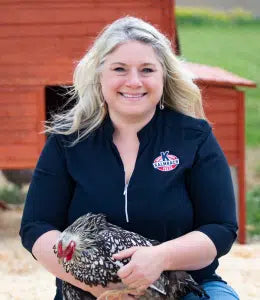Heat Stress in Chickens: Signs, Treatments, & Prevention Methods

Baby, it’s hot outside! With soaring summer temperatures in many regions, the effect of heat stress on your hens can be very concerning. We recently wrote about how chickens regulate their body temperature, and today, we are going to talk about what happens when your hens are stressed by the hot weather.
What is Heat Stress in Chickens?
Heat stress in chickens means that the chicken is too hot. Chickens are naturally warmer than humans, with a healthy body temperature of 105-106 degrees Fahrenheit. They don’t sweat and rely on more passive cooling mechanisms like cool water and shade. Heat-stressed chickens can get sick and stop laying eggs, but more serious cases can be fatal.
What Are the Signs of Heat Stress in Chickens?
Heat stress can affect every part of your chicken’s health and life. Signs of heat stress in chickens include:
- Moving less
- Fatigue and lethargy
- Panting
- Elevated wings
- Drinking more water
- Eating less
- Loss of weight
- Pale waddle and comb
- Reduced egg production
- Going limp
- Unconsciousness
Heat stress also causes physiological changes in your chickens. Hormone levels change, and chickens become less fertile. Heat stress also changes chickens' acid/base levels and respiration and causes oxidative stress.
Can Heat Stress Affect Egg Production?
Yes, once the ambient temperature reaches 85ºF, egg production will start to drop. This is usually a direct result of dealing with the effects of heat stress. Any time an animal is stressed, reproduction is one of the first physiological functions that she will slow or cease. Since egg production is reproduction, it makes perfect sense that we can see 15-40% reductions in egg production during periods of heat stress. Egg production may cease altogether if hens are dealing with heat stress during sustained heatwaves or periods of very high humidity.
- Another common side effect of heat stress is thin eggshells. As a hen pants to dissipate heat, her lungs produce large amounts of CO2, which has a negative effect on the pH of the bloodstream. Due to this pH imbalance, calcium in her bloodstream is bound to other nutrients, directly resulting in less calcium available for eggshell production. This problem can be further exacerbated because feed intake and, thus, calcium intake are usually reduced in hot weather.
- Another common culprit that affects egg production in the summer is water quality. Even a short amount of time without potable water can cause a hen to stop laying eggs. Additionally, once the temperature of drinking water exceeds the internal body temperature of the hen (105ºF), she will stop drinking the water because it will heat her body and exacerbate heat stress.
What is the Ideal Temperature for Laying Hens?
Poultry cannot sweat and rely on other methods to regulate their temperature. The internal body temperature of a healthy adult chicken is about 105ºF. Chickens will use their breath, the surface area of their body, and even their blood to help regulate their body temperature.
- Ideal Temperature Zone: The ideal temperature (thermal neutral zone) for an adult laying hen is 64 to 75ºF. In this temperature range, hens do not need to adjust their metabolism to regulate their body temperature. Below this range, hens will need to generate heat to stay warm. Above this range, hens will need to work to release heat from their bodies.
- It’s Getting Uncomfortable: Between 75 and 95ºF, hens will use a variety of methods to help release heat from their bodies and maintain homeostasis. In this temperature range, your hens may be uncomfortable, but their natural bodily functions – panting, vasodilation, gular flutter, etc. – are usually adequate to deal with this stressor for a short period of time. As poultry keepers, we can help our hens cope by providing plenty of shade, good airflow and ventilation, and plenty of clean, cool water.
- The Danger Zone: If the temperature inside a chicken’s living quarters reaches 95ºF, a hen’s ability to cool herself becomes limited, and this can quickly result in heat stress. If the ambient temperature meets or exceeds the internal body temperature (105ºF), chickens have no way to cool themselves. This can very quickly lead to an emergency situation for your feathered friends.
How To Treat Chicken Heat Stress
If heat stress becomes extreme and your chicken pants heavily, has a pale waddle or comb, is limp, or is unconscious, treating your chicken’s heat stress immediately is essential.
- Submerge the chicken up to the neck in clean, cool (not cold) water, ensuring it can breathe.
- Move the chicken somewhere cool where it can recover.
- Take steps to prevent future heat exhaustion.
How To Prevent Heat Stress in Chickens
- Cool, fresh water: The very best way to help your chickens stay cool is lots and lots of fresh, cool water. During hot summer weather, you can expect your hens to drink 2.5x more water than they would consume if the temperature were in the ideal range (64 to 75ºF). This water is being used to replace the large volume of moisture a hen loses when she is panting. (Water is also required for egg production. A standard Grade A large egg is about 70% water. Your hens need a massive amount of water to maintain proper body temperature and to keep producing eggs!)
- Shade: Make sure your chickens have access to plenty of well-ventilated, spacious shaded areas.
- Airflow/Ventilation: Openings in your chicken coop at ground level make any airflow cooling for your chickens. Outdoor fans are a must for areas without breezes. Place enclosures so they catch any breezes.
- Misters: One trick is to use a timer to set your misters for the afternoon when the heat is most extreme.
- Ice: Blocks of ice and frozen water bottles will stay cold and keep your chickens cool for several hours.
